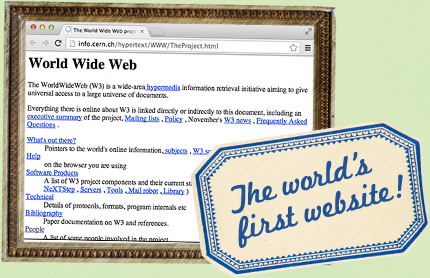3 years have passed since my arrival to W3C but not a day has passed without feeling excited about being able to work in the same office with THE founder of the Web, Tim Berners-Lee. In this feature, let's find out how Tim came about to inventing the Web, what exactly is the Web? and what kind of an organisation is the W3C? I would like to introduce the history behind these facts as simple as possible.
Curriculum Development LeadW3C is the most prominent international organisation responsible in developing the necessary technologies in Web site production as well as developing protocols and guidelines to standardise them. Mr. Yamada is currently stationed in the W3C HQ as a visiting researcher at Massachusetts Institute of Technology (MIT) located in Boston, America. He is currently in-charge of developing HTML as well as INTERNET ACADEMY's curriculum.

The founder of the Web is Tim Berners-Lee, a British scientist. He invented the WWW (World Wide Web) which is the most important system of the Internet. He is most recently remembered as the person addressing the closing speech of the 2012 London Olympic games.

Therefore, the "www" used in www.internetacademy.co.in as well as other URLs comes from the WWW that Tim invented. So, why did Tim name the system WWW?

Tim used to be a scientist at CERN, the European Organisation for Nuclear Research, an organisation that carries out researches on particle physics. Being an organisation that carries out researches that requires a vast amount of time, researches go on with thousands of researchers successively taking over their predecessor's work.

It was then where discussions started to brew at CERN about whether it was possible to develop a system that can enable researchers to view data and information smoothly. The person who acted to materialise this idea was Tim Berners-Lee who was at that time a Computer Engineer at CERN. First, Tim gathered all the references and data related to the research on one computer. Next, he planned a mechanism to “link” all the documents together and he succeeded. That was what we have been using up till today, the World Wide Web, in other words, the beginning of the Web.
It was rumored that Tim had a hard time coming up with a name for this system for its announcement. One the names considered was "TIM", the acronym for "The Information Mine" and of course, Tim's name! He later revealed in his own Web site that he gave up the thought as the name was too self-centered!

Another name considered was "Mesh" which was derived from the concept of the WWW being a "Network of information made up of linked documents". However, the word "Mesh" can easily be mistaken for "Mess" and was therefore deemed inappropriate by Tim to avoid it being mistaken as a "World Wide Mess"! After careful consideration, Tim replaced the word "Mesh" with "Web" reason being a structure of a network resembled that of a "Spider's web" and therefore, he named the system "World Wide Web" which represented a "Spider web spreading out to the World". The word "Web" as in Website that we having been using is a product of Tim's flash of inspiration.

On 6th August 1991, Tim published the World's first Website. This is the most commonly recorded birthday of the Web. The most impressive feature of Tim's publication was the system of linking documents together called the "Hyper Text". Hyper Text as its name suggests, was self-explanatory. The function of being directed to another Webpage simply by clicking a "link" is almost a matter of fact to us these days. Text that possesses this function is called a "Hyper Text". This was also Tim's initiate objective for devising a Website to interlink references and research data of the researchers. Tim named the language used to create Websites by taking the acronym of "HyperText Markup Language", HTML. Tim really has a remarkable naming sense!

Along with the publication of the Website, Tim also announced a software called the "WWW Client". This software is the "Web Browser" that is being used to view Websites. The widely used browsers today include browsers such as "Internet Explorer", "Google Chrome", "Firefox" and "Safari", that is used for viewing Websites on iPhones and iPads. Tim announced this "WWW Client" to be free to the world and on top of that, he also announced the mechanism behind the method of creating this software for free. No strings attached! Hence, the Web belonged to no one, everybody was free to use it and that led to its remarkable evolution today.

The Web that can be freely used by anyone presented itself as a big chance in the business world. Targeting this, new Web browsers were being created one after another. For a start, America's National Centre for Supercomputing Applications (NCSA) launched a browser called the "Mosaic". The Mosaic was a big hit with its feature that enabled images to be published.
Following Mosaic, two Web browsers, the Netscape and the Internet Explorer were released around 1995 and these two browser giants rivaled each other for a few years. 1995 was also the year where "Windows 95" was launched and that led to the rapid increase in personal computers possession in households. This year, INTERNET ACADEMY was born.
However, it was not all rainbows and butterflies with the existence of multiple browsers. In the midst of the competition, Web browser companies started to add flashy features and each of them developed their own exclusive rules spurring the outbreak of the "war between the browsers". This resulted in a major confusion for Web designers and engineers since they had to create Websites following 2 different set of rules for the same Website just to display the same content on the 2 different browsers.
It was then when Tim saw the need to standardise the rules for HTML and established the World Wide Web Consortium (W3C).

During the period when Tim invented the Web, the main intention of CERN was to focus on the research on particle physics. Being unable to focus fully on the development of the Web, the 1 person who offered the greatest support to Tim was MIT Professor Michael L. Dertouzos. Michael, being a researcher in Computer Science at MIT, expressed exceptional interest in the potential of the Web.
Thus, gaining the support from CERN and the United States Department of Defense which developed the base technology for the Internet, Michael, who was the director of MIT's Computer Science Research Centre (LCS, present day CSAIL), established W3C. At the same time, Tim affiliated himself to W3C. The Web is surprisingly born in Europe and raised in America!

W3C, with its 4 host organisations, America's MIT, Japan's Keio University, France's European Research Consortium for Informatics and Mathematics (ERCIM) and China's Beijing University of Aeronautics as its core, is currently co-operating with approximately 400 W3C member companies around the world. In Japan, there are 23 IT related companies (as of Feb 2013) affiliated as members of W3C and INTERNET ACADEMY is the only recognised Educational Institution with its staff being put in charged of developing the HTML curriculum at W3C's MIT HQ. In addition, INTERNET ACADEMY also has W3C's Japan Host organisation, Keio University's W3C overall person-in-charge, Masao Isshiki, as its advisor and thus allowing INTERNET ACADEMY to have close collaborative relations to the standardisation of the Web.


Today, countless new services and businesses such as Google, Amazon, Facebook and the iPhone etc. have emerged. With W3C welcoming its 20th year in the creation of HTML rules, they have plans to officially release the next generation's HTML, the "HTML 5", in 2014. HTML 5 does not only fulfill its role as a technology for Website creation but it has also been evolved to handle the creation of applications in various environments regardless whether the application is for Windows, Mac, iPhones or even Android phones.

On top of that, the list does not stop with personal computers and smart phones. The application of HTML 5 can exist anywhere as long as there is a browser involved. To put it simply, this ranges from television systems, car navigation systems, electronic signboard systems etc. In addition, according to current technological trends, display panel-integrated systems (through the adoption of browsers) such as air-conditioning, refrigerators and other household appliances operations being connected to the Web are making the everyday news.
Allow me to make 1 such example. Japan's national television station, NHK, recently started a service called the "Hybridcast" on September 2013. This broadcast system integrates information of television programs with Internet communications to synchronise the display on television screens to viewers who possess smart phone or tablet accounts allowing them receive real time broadcasts of television programs leading to an evolutionary television broadcasting service.

Imagine this scenario, a father, a mother and a daughter are watching the same quiz television program. During the television broadcast, the program host asks a multiple-choice question and these choices are being displayed on each of the viewer's smart phone allowing them to make their choice. Then, the host reveals the answer to the question to the celebrities participating in the program and at the same time, the choices of the 3 viewers are being displayed on the screen. This is as if the 3 viewers are participating in the quiz program as well. Therefore, this new technology allows the production of such evolutionary quiz programs possible.

NHK is currently producing such contents using HTML 5. Precisely because the usage of the Web is free and the technology is moving towards global standardisation that makes the training of technicians needed to produce such contents easy and possible. As long as a browser is integrated in the system, television program producers can make such similar programs. In the near future, we may be able to expect a great demand of Web designers from television broadcast and production companies.

The example raised here is only about the television industry but there are many other industries such as household appliance manufacturers, advertising companies, automotive companies, publishers etc. also moving in the same direction towards this revolution. On a side note, in the US, long time leader in the IT industry, it is expected that there will be a shortage of approximately 1 million IT proficient personnel in respect to 1.4 million IT positions in the year 2020. Therefore, the vast and unforeseeable potential for personnel with HTML 5 skill and knowledge is the centre of attention for all industries.









